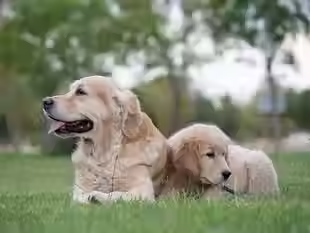

Why Do Dogs Eat Grass? What You Should Know This Spring
Apr 26
2 min read
1
11
0

As the weather warms up and the grass turns green again, you might notice your dog spending a little too much time nibbling on the yard. If you’ve ever wondered, “Why does my dog eat grass?” - you’re not alone. It’s one of the most commonly asked questions by dog owners, and now that spring has arrived and the “yummy” grass is back, it’s the perfect time to talk about it.
Is It Normal for Dogs to Eat Grass?
In most cases, yes - it’s completely normal. Grass-eating is a common behavior seen in many dogs, and it doesn't necessarily mean something is wrong. While it can seem strange, especially for pet parents who feed high-quality diets, the behavior is usually harmless.
Why Dogs Might Eat Grass
There’s no one-size-fits-all answer, but here are the most common reasons:
It Tastes Good (Especially in Spring!) Fresh, tender spring grass is especially appealing to dogs. Think of it like seasonal produce - they know when the good stuff is out.
It’s a Source of Fiber Some dogs may instinctively seek out grass to help with digestion. Grass contains fiber, which may support gut function.
It Can Induce Vomiting In some cases, dogs eat grass to make themselves vomit if they’re feeling a little off - though not all grass-eating ends in throwing up.
It’s Boredom or Stress-Related A dog that’s under-stimulated, anxious, or left alone too often might chew grass simply to self-soothe or stay busy.
They Just Like It Simple as that. Some dogs just enjoy the texture, smell, or act of grazing - especially during spring when the grass is fresh and flavorful.
When Should You Be Concerned?
Most grass-eating behavior is not a problem. However, you should keep an eye out for:
Excessive grass consumption
Frequent vomiting or signs of illness
Lethargy or changes in appetite
And most importantly, make sure your dog isn’t eating grass that’s been treated with pesticides or fertilizers, which can be harmful or even toxic.
How to Manage Grass-Eating Behavior
If you’d prefer your dog not turn your lawn into a salad bar, here are a few ways to manage the behavior:
Make sure their diet is balanced and nutritious
Provide more physical and mental enrichment (walks, puzzles, training sessions)
Redirect the behavior with a toy or training cue
Use a leash to guide them away from unwanted grazing
Final Thoughts
As spring kicks into gear and the green grass rolls in, don’t be surprised if your dog gets the urge to snack. In most cases, it’s harmless - but like all behaviors, it’s good to understand the why behind it.
If you’re ever unsure whether your dog’s grass-eating is normal, or you want to address it with structure, we’re here to help.
Contact us at Perspective K9 to learn more about behavior support and training solutions.





